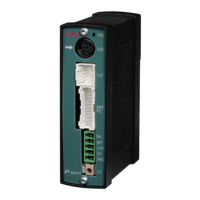How to resolve parameter data error of IAI ASEP Controller?
- AAndrew ConnerAug 27, 2025
If the data input range in the parameter domain is not correct in IAI Controller, change the value to the correct one referring to the user parameter table.

How to resolve parameter data error of IAI ASEP Controller?
If the data input range in the parameter domain is not correct in IAI Controller, change the value to the correct one referring to the user parameter table.
How to resolve position data error in the movement of IAI ASEP?
If the value corresponding to the specified position is not set in IAI Controller, set the effective value in the Position Setting operation.
How to fix command deceleration error in IAI Controller?
If the command issue timing for velocity change during the movement is too late in IAI Controller, issue the command much earlier so that the actuator does not exceed the soft limit and an over-chute is not caused.
What to do if position data error in IAI Controller?
If the movement command is issued while the target position has not set on the Position Data or the target position value set on the Position Data exceeds the soft limit set value in IAI Controller: * Set the target position. * Change the target position value to the one within the soft limit set value.
What to do if there is an overvoltage error in the IAI ASEP Controller?
To resolve the overvoltage error with the IAI Controller, check the input source voltage. This can occur if the source voltage in the 24V power unit is too high or if there is a breakdown of a part inside the controller.
What to do if there is a position data error in the IAI ASEP Controller movement?
To resolve a position data error in the movement of the IAI Controller: * Set the target position. * Change the target position value to one within the soft limit set value. This error occurs if the movement command is issued before setting the target position or if the target position exceeds the soft limit.
What to do if the IAI ASEP Controller displays a Z-Phase Detection Time Out error?
If the IAI Controller displays a Z-Phase Detection Time Out error: * Check the actuator cable wiring condition. * Confirm that there is no error in the mechanical part assembly condition. * If the load weight is normal, move the actuator by hand to check the sliding resistance after the power is turned OFF. Potential causes include loose cable connections, brake not released, excessive motor load, or high sliding resistance in the actuator itself.
What to do if the IAI ASEP Controller displays a software stroke limit over error?
If the IAI Controller shows a software stroke limit over error: * Set the deceleration curve so that an over-chute is not caused when the actuator is stopped. * Return the actuator within the soft limit range and perform the servo-motor turning ON operation. This error can occur if the actuator exceeds the soft limit due to high load or deceleration settings (especially in vertical installations) or if the actuator is moved out of the soft limit range when the servo-motor is OFF.
What to do if the IAI ASEP Controller has a control power source voltage error?
To correct a control power source voltage error in the IAI Controller, check the input source voltage. This issue can arise if the source voltage in the 24V power unit is too high or due to a breakdown of a part inside the controller.
How to fix position data error in the movement on IAI ASEP Controller?
To address a position data error in the IAI Controller, set the effective value in the Position Setting operation.
| Operating Temperature | 0 to 40°C |
|---|---|
| Storage Temperature | -10 to 60°C |
| Vibration Resistance | 4.9 m/s² (0.5 G) or less |
| Protection Class | IP20 |
| Number of Axes | 1 |
| Communication Interface | Ethernet, RS-232C |
| Power Supply | 24V DC |
| Humidity | 20 to 80% RH (non-condensing) |
| Control Method | Position, Speed, and Torque Control |
| Programming Language | Proprietary language (IAI language) |
General safety precautions for robot operation to prevent injury or damage.
Guidance on teaching tools, data backup, operation patterns, and signal inputs.
Details on RoHS, CE Marking, and UL compliance for the products.
Steps for initial settings, power checks, servo ON, and safety circuit verification.
Identifies key controller components like connectors, LEDs, and indicators.
Illustrates rod, slider, table, arm, gripper, and rotary actuator axis types.
Lists product parts, required teaching tools, and related manuals for setup.
Provides external dimensions for controller models and the absolute battery unit.
Details PIO interface specifications, voltage, current, and circuit diagrams.
Guidelines for proper grounding, wiring, and noise reduction techniques.
Shows overall wiring connections for controller, battery, and actuators.
Provides circuit diagrams for power, emergency stop, and PIO pattern examples.
Details wiring for power supply, FG terminal, actuator, PIO, SIO, and battery connectors.
Guides through initial configuration steps using PC software or Touch Panel.
Explains input signal requirements and time constants for reliable operation.
Illustrates timing for point-to-point, pause, speed change, and pressing operations.
Details user parameters for positioning, speed, gain, torque, and other settings.
Provides step-by-step guidance for servo adjustment based on model and situation.
Details alarm classification, cancellation methods, and comprehensive troubleshooting for errors.
Lists detailed specifications for various connectable actuators.